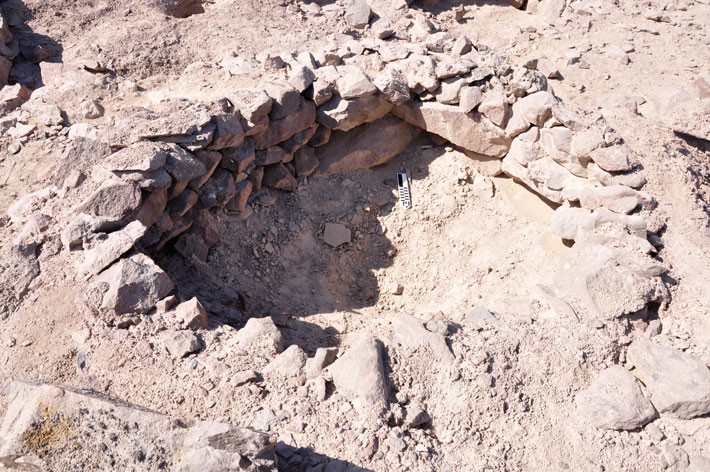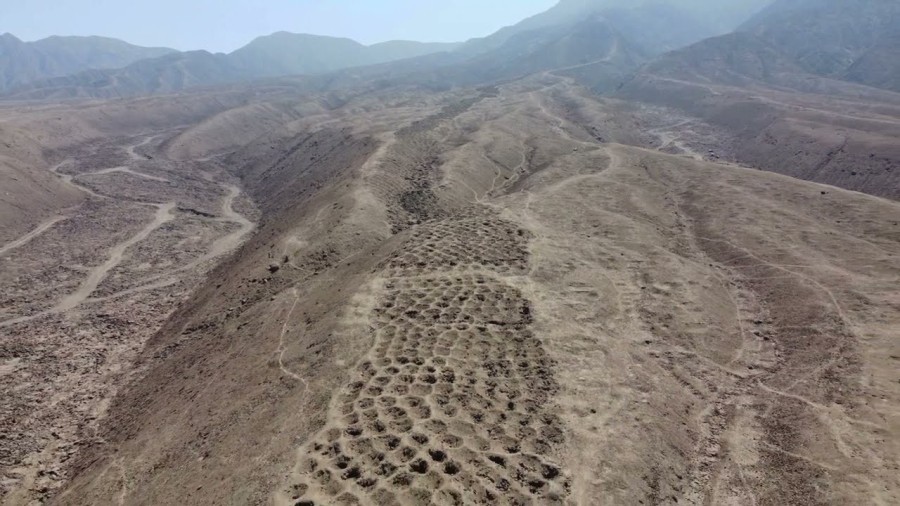
The Band of Holes in a photograph taken by drone. The road stretches for a mile up a mountain top and may be the remains of a structure used for collecting and measuring food tributes for the Inca state.
Charles Stanish
The Inca Empire covered vast parts of South America, uniting distant cities in Chile, Peru, and even Argentina with well-engineered highways. Sophisticated agricultural systems and architecture allowed the Inca to live on the steep slopes and jagged peaks of mountains. And they did it all without money or markets as we know them. Instead, Inca leaders had an elaborate system of tributes or taxes that took the form of the land’s most precious resource: food.

But how do you quantify many different forms of tribute—from squash and rope to corn and peppers—without a system like money to measure exchange value? Perhaps by inventing other systems of measurement. Archaeologists are exploring a mile-long road made entirely of shallow, rock-lined holes that may have once been a dropoff point for Inca food tributes. Dubbed the “Band of Holes,” the road climbs the slope of Peru’s Monte Sierpe in a region that has been home to complex human settlements for thousands of years. The rock here is so hard that the people who built it did not bother to dig their carefully sized holes (each is about 3 feet wide and 20 to 40 inches deep); instead, they constructed the nearly 6,000 holes out of soil and fist-sized rocks they brought from elsewhere. Seen from above, the Band of Holes looks like ribbon of precisely placed firepits or maybe an infinite punchcard.
Though locals have always known about the Band of Holes, it’s possible that archaeologists have ignored it because it’s hard to see except from the air. The first modern-day record we have of the structure comes from an aerial photograph taken in 1931, and today two archaeologists, Charles Stanish and Henry Tantaleán, are exploring it with drones.

Over at Archaeology magazine, Eric Powell has a fascinating article about the site, which is as controversial as it is mysterious. The Band of Holes was definitely within Inca territory at the time of European colonization, but the region was also home to many pre-Inca civilizations—including a group known as the Chincha who were conquered in the fifteenth century by the Inca, shortly before the Spanish arrived. In fact, archaeologist Stanish is known for discovering art and artifacts from a sophisticated culture that occupied the Chincha Valley region more than 2,300 years ago, long before the Inca empire rose. So the Band of Holes could have been made by one of these groups or created by one and appropriated by the next.
That said, Stanish and Tantaleán say there are strong pieces of evidence to suggest the Band of Holes was used by the Inca. They’ve found Inca pottery in the area from the period shortly before European colonization; plus, the Band of Holes is located conveniently close to a well-used Inca highway and an Inca storeroom known as a colca. It was really the colca that clinched the deal for Stanish. While ancient cities in other empires had dramatic marketplaces at their centers, Inca cities had vast colcas. Food and textiles were provided to members of the Inca state from these storehouses. The floors of many colcas look like graph paper—they’ve been carefully divided into mathematically precise boxes for measuring tribute brought from all over the empire.
Enlarge / A close-up look at one of the pits in the Band of Holes. Each one is about 3 feet wide and 20 to 40 inches deep. They were not dug into the rock, but built from imported rocks and soil.

Charles Stanish
Early European visitors to Inca cities wrote about watching farmers bringing their produce as tribute. A state official would record each tax using the Inca’s unique writing system, known as khipu, which consisted of tying very precise knots of various colors onto strings. Completed khipu manuscripts look almost like vast macrame wall hangings. Unfortunately we still know very little about how to read khipu because the Spanish burned all the great khipu libraries (there is a khipu translation project, but it has to work with whatever remaining khipu archaeologists can recover—often, they are found in old colca). Once the tributes were recorded in khipu, the squares were cleared and the process began again.
Stanish was struck immediately by the similarities between the colca floor pattern and the Band of Holes. He and Tantaleán believe the Band of Holes could be a local, Andean version of the Inca tax tribute building. It doesn’t look precisely like other colca, perhaps because it was far enough from the center of the Inca empire that local customs had influenced its structure. But its location near a storehouse does suggest that people might have brought food to the Band of Holes for measurement and then stored it for later redistribution. Before we can know for certain, more work will have to be done. Scientists might take soil samples to test for traces of ancient pollen or other pieces of plant tissue that can last for centuries. If we find those traces, it would bolster Stanish and Tantaleán’s case that the holes once held food tribute.
But if not, we could be looking at some other kind of storage structure, perhaps for fuel or fertilizer. Or maybe the Band of Holes is geoglyph art, similar to the Nasca Lines, which represent some of humanity’s first efforts to measure out our lives by creating something bigger than ourselves.